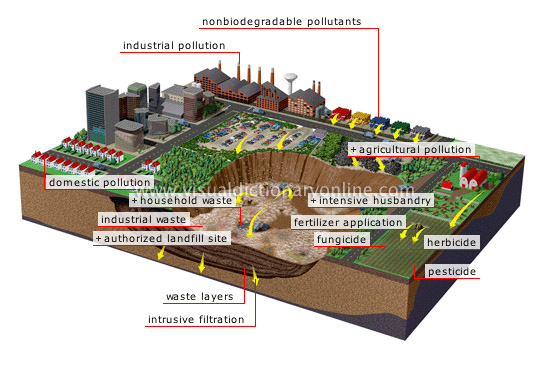land pollution
Numerous factors contribute to soil pollution (e.g., household and industrial waste, fertilizers, pesticides).
intensive husbandry 
Animal dung introduces large quantities of nitrate into the soil; the nitrate then filters into the water table.
nonbiodegradable pollutants 
Products that cannot be completely decomposed by living organisms.
industrial pollution 
Most nonbiodegradable soil pollutants are produced by industry, which discharges more than 700 different substances.
domestic pollution 
Pollution generated by an increase in household waste and detergent spilled into wastewater.
industrial waste 
Some of it is treated in the same manner as household waste, while other forms containing toxic substances are processed at specialized sites.
household waste 
It is composed mostly of biodegradable organic matter but also contains plastics, detergents, solvents and heavy metals.
authorized landfill site 
Land that is filled with household and industrial waste and then covered with successive layers of earth.
waste layers 
Each waste layer is sealed using a plastic film or a base layer of clay.
intrusive filtration 
In spite of the sealing of waste layers, rainwater runoff allows certain pollutants to seep into the subsoil.
fungicide 
It is used to destroy parasitic fungi on crops.
pesticide 
Product (insecticide, herbicide or fungicide) that destroys harmful organisms. It sometimes enters the food chain and affects flora and fauna.
herbicide 
It is used to destroy or limit the growth of plants harmful to crops.
fertilizer application 
The excessive use of fertilizers leads to an increased quantity of mineral compounds in the soil and in farmed crops.
agricultural pollution 
It has developed with the intensification of agriculture and the large-scale use of fertilizers and pesticides.













